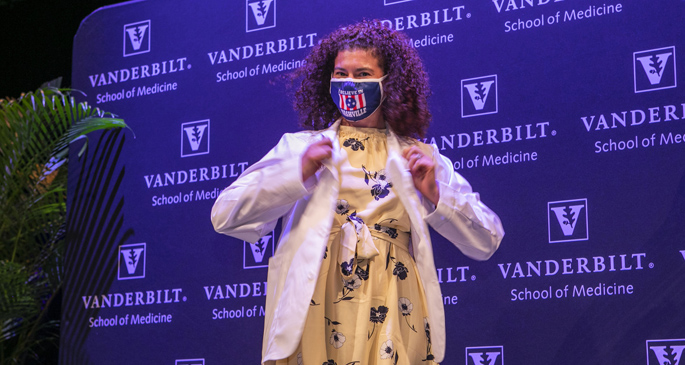
by Kathy Whitney
In keeping with tradition, the Vanderbilt University School of Medicine first-year class held its White Coat Ceremony on Aug. 5.
Despite a few aspects of the ceremony being altered due to physical distancing measures put in place with COVID-19, the students enjoyed the right of passage marking the beginning of their medical education journey.
The ceremony was held in Langford Auditorium rather than Light Hall. Family and friends tuned in via livestream video.
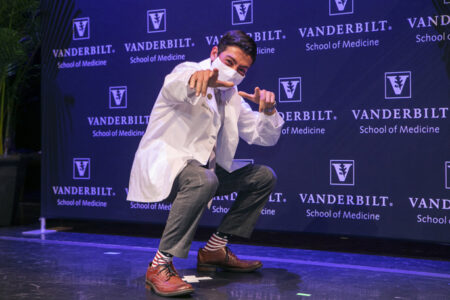
Jeff Balser, MD, PhD, President and CEO of Vanderbilt University Medical Center and Dean of Vanderbilt University School of Medicine, welcomed the 96 members of the class, which includes 77 MD, 15 Medical Scientist Training Program (MSTP), three Medical Innovators Development Program (MIDP) and one oral and maxillofacial surgery students.
“The White Coat ceremony is an important milestone in the remarkable journey you as medical students have undertaken. While we would prefer to have family and friends here in person, given the extraordinary circumstances of the global pandemic our leadership team has made adjustments to assure this is a memorable experience,” Balser said.
Fifty-five percent of the new first-year class are female, 45% are male, 30% are under-represented in medicine and 4% are international. They come from 55 undergraduate schools, with 59% taking time off before matriculation. The GPA range is 3.5 to 4.0 and the MCAT range is 74th to 100th percentile.
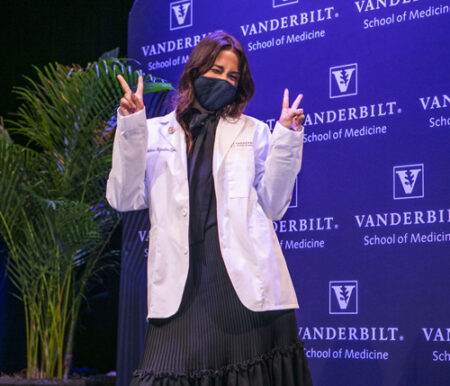
“Entering medicine right now is an unprecedented experience given what’s going on. Unprecedented simply means it hasn’t happened before. Unprecedented begets opportunity. You have the extraordinarily good fortune to enter medicine at a time when you can help influence how the world survives through and thrives after COVID,” said Donald Brady, MD, Senior Associate Dean of Health Sciences Education, as he addressed the students.
MIDP student Emma Neal, PhD, whose research focuses on techniques to model and interrogate central nervous system disorders, realized that she wanted to have an active role in patient care outside of her research capacity.
“I wanted to be able to extend the skillset I built throughout my graduate research to solve clinical problems that would directly impact patient care. The MIDP at VUSM is an absolutely perfect fit for helping me achieve my career goals,” she said.
First-year classmate Stefan Koester is from Scottsdale, Arizona, and graduated at the top of his class from University of Arizona Honors College where he studied physiology.
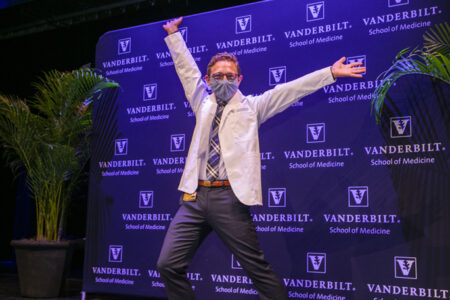
Throughout college, he started a biological honor society, played competitive tennis, received EMT training, and volunteered in a local middle school mentorship program and medical group that provided border medicine in Arizona. He recently earned his master’s degree in Management from the London Business School.
“I chose Vanderbilt…because Vanderbilt seemed like a truly interdisciplinary hospital rooted in both a massive patient care center and unending resources for research. I was drawn to the Curriculum 2.0 throwing students earlier into clinical training, and Vanderbilt has been clear about its student mission from the beginning, which is not training future doctors, but training the doctors of the future,” Koester said.
The class has a combined 175K+ research hours, 68K community service hours, and 41K medical exposure hours. They hail from 30 states and among them are dancers, musicians, student athletes and an Eagle Scout.
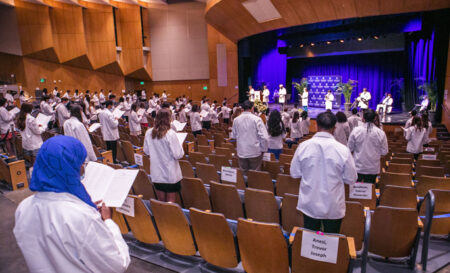
First-year student Andrea Lopez took a gap year after graduating from the University of Tennessee Knoxville in 2019 and worked at Vanderbilt University Medical Center for the GI Clinical Research Enterprise on a colorectal cancer study.
“I loved being part of this team and they taught me so much about the intersection between research and clinical care,” she said.
Lopez said she is proud to have grown up as an undocumented immigrant, a daughter of a single mother, and a house cleaner because “it has cultivated in me the resilience and empathy to take on the multifaceted and demanding role of a physician. Therefore, I needed to be at a school that understood the value in diversity and increasing representation in the medical field.”












